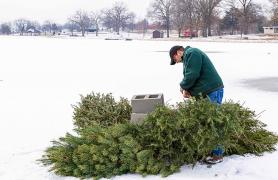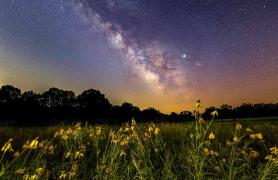Leave nothing behind but footprints on the landscape,” said Serena Hagler to her students prior to their departure for Maramac Springs.
It was just one of the school’s many outdoor field experiences with Discover Nature Schools (DNS). “And look for animal tracks or footprints to help us better understand their behavior and follow their movements.”
With science notebooks in hand, the sixth graders of Licking Elementary School spent the day studying animal tracks and sign, testing water quality, collecting stream data, and studying human impact, both positive and negative. The students were elated to even carve out time for fishing. At the end of the day, just as Hagler had requested, the landscape at Meremac Springs showed no trace of the multitude of students exploring there, other than the muddy footprints the class left behind. In addition to physical footprints, Hagler left another set of lasting imprints behind, but not on the landscape.
Footprints of a different kind — a lasting kind — were clearly left for each student to follow. The footprints of stewardship, modeled by their teacher in each nature-based lesson, undoubtedly left an indelible set of tracks for the next generation of conservationists to follow.
Hagler, a science teacher at Licking School District, is one of the many hundreds of teachers across the state who take part in MDC’s curricular program, Discover Nature Schools. Since 2007, Hagler has provided her classes with firsthand experience with glades, f loodplains, forests, ponds, rivers, and prairie landscapes.
Blazing a Trail
First developed in 2006, DNS has created nature-based curricula for preschool through 12th grades. DNS units encourage inquiry-based exploration of science with a Missouri-specific appeal.
“It’s one of the few instructional units available that actually provides teachers with the tools necessary to help kids learn about Missouri plants and animals,” said Kevin Lohraff, Runge Conservation Nature Center manager. “It focuses on what’s happening right outside their door.”
Lohraff and the nature center staff see countless students annually visit the center as part of their DNS programming.
With a vast amount of nature-specific learning components to be completed outside, DNS students engage in hands-on learning in nearly every lesson. Beyond conveying conservation content, these units align with the most current Missouri Learning Standards set forth by the Missouri Department of Elementary and Secondary Education (DESE). Lesson and unit creation and revisions are done regularly to ensure relevance to those standards as well as other academic educational trends.
DNS units are outlined into five progressive, or scaffolding, instructional units, covering standards from preschool through grade 12. Complete teacher guides, full-color student texts, and scientific inquiry notebooks are available, free of charge, to all participating schools. Teacher training and professional development is offered by MDC’s conservation educators, located regionally across the state. In addition to free materials and educator training, DNS offers a grant program to trained teachers and districts to allow for purchase of exploration equipment, field investigation tools, field guides, and other materials necessary to implement the units. The DNS grant also allows for transportation costs for school districts who conduct field experiences.
More than Just Words in a Text
One of the most rewarding aspects of the DNS program, according to Hagler, is the ability for the text to come to life when students get to experience firsthand science concepts in their own communities and schoolyard.
”My kids become engaged in science content when it relates to their own frame of reference — what’s in their backyard,” she said. “Technical content that is sometimes difficult to get students engaged in, such as biomes and interactions between organisms and their environments, have them fully involved using DNS. Anytime learning objectives become more than just printed text, and become relevant to kids’ daily lives and interests, that’s when you have immediate student buy in.”
One of Hagler’s favorite units was a food web simulation. Students would role play an organism and interact with other organisms that they would either eat or get eaten by, physically connecting themselves with a string.
“Again, its hands-on learning,” she said. “I then pose a disaster-type scenario, such as a drought that eliminates an organism, and we see how it affects the whole ecosystem. This becomes real when students do more than just read the terms on a page.”
Another favorite of Hagler’s class is an activity where students role play deer in a forest and find out what is needed for survival when resources are either scarce or abundant.
“Most of my students are either avid deer hunters or from a family that values deer, so this lesson really connects and teaches competition in a meaningful way.”
Many teachers across the state use the DNS units in a versatile manner. One of the appeals is the flexibility of teacher implementation if their district already has a science text in place. This allows for teachers to use DNS as a standalone curriculum or supplement.
“I use the Nature Unleashed curriculum for teaching my unit on ecosystems rather than using the chapter from my school’s purchased science textbook,” Hagler said. “The Nature Unleashed curriculum is very well aligned with the DESE Learning Objectives for science, and uses the same vocabulary that I traditionally teach, just in a more hands-on way than our school text.”
One of Hagler’s science students, Elan, expressed the importance of this hands-on learning.
“It’s kind of hard just to learn big things out of a book,” Elan said. “Before we got to do a simulation to learn about trophic levels, I didn’t know what they were. Once I could see it with my eyes, I finally knew about how energy is transferred in an ecosystem. We saw it by doing it. We figured out who eats who in nature and how plants and animals transfer energy.”
Why Take It Outside?
Much study has been done regarding the benefits of outdoor exposure on
childhood development and learning. Volumes of academic writings have touted the benefits of regularly scheduled outdoor learning components in a school setting, such as boosting concentration, increasing academic engagement, reducing stress and behavioral health concerns and patterns. Students with special needs and varying learning styles seem to thrive in an outdoor learning environment. These student-centered benefits of regular, nature-based educational opportunities are a driving force in updating and revising each DNS unit.
One of the greatest appeals to students is that most lessons contain an outdoor component that focuses on critical thinking and inquiry skills that allows for outdoor data collection, scientific record keeping, and hypothesis creation on many levels. DNS was founded on inquiry and place-based education that allows for experiential learning in a Missouri-specific way. Educational trends across the nation support this strategy amongst all curricular domains. Taking these lessons into the schoolyard opens a myriad of inquiry-based phenomena for students to explore. Lessons are geared to be cross-curricular, allowing for nontraditional students, as well as students across the academic continuum, to excel. Higher order thinking skills are engaged throughout the units, and many units end with an outdoor group activity that builds on previous lessons.
No Schoolyard, No Problem
Outdoor components can be carried out even in the smallest of playgrounds and courtyards. Rural and urban districts alike have utilized DNS in their districts and are frequently surprised at how small of a space is needed to conduct outdoor investigative lessons. In their DNS training, teachers learn even the smallest spaces are teeming with nature and are encouraged to utilize all types of schoolyard environments. Teachers are also trained in the “art of looking” to help foster a student’s natural sense of wonder in the outdoor world, both on a large and small scale. DNS lessons facilitate this concept, in and outside of the classroom.
Aiming for More Than Academics
While DNS is used in traditional classrooms across the state, homeschool groups, as well as private and parochial schools and student community groups, also have benefited. In addition, teachers of students with special needs have expressed support of the DNS curricula for the flexibility of use in accommodating various learner needs.
“I have used DNS with both regular education students and in years spent working with students with special needs,” said Jennifer Scott, teacher with Success R-6 Elementary. “This program keeps all students actively engaged and lets students of all ability levels become active participants in the lessons.”
Students with specific behavioral and emotionally specific needs seem to benefit from the program as well.
Discover Nature Schools
Discover Nature Schools (DNS) is built on five educational units, each consisting of age-appropriate content and aligned with Missouri Learning Standards. DNS is also available for homeschool groups.
The program averages nearly 1,700 public and private schools in a given year. DNS reaches over 75,000 students per year, and over 400,000 students have gone through the program since its inception in 2006. MDC’s conservation educators make DNS happen on the local level. They continually provide workshops and support for teachers in the DNS “train the trainer” model. For more information on DNS, including grants available for transportation and field experiences, workshops, and sample units, visit short.mdc.mo.gov/Zxx.
- Nature Revealed (Pre-K) is a diverse collection of learning experiences that give Pre-K teachers and parents the planning tools, activities, and resources to stimulate children’s sense of wonder of nature.
- Nature Unfolds (K-2nd) introduces young students to the life cycles, seasons, weather, and basic needs of plants and animals through hands-on activities and a fully illustrated student book.
- Nature Unleashed (3rd-5th) helps elementary students understand ecosystem connections through exploring Missouri’s ponds, forests, and prairies inside and outside the classroom.
- Nature Unhooked (6th-8th) covers all elements of aquatic ecosystems, from the properties of water molecules to the diversity of aquatic life, and how we conserve and enjoy Missouri’s aquatic ecosystems.
- Nature Unbound (9th-12th) helps high school students understand the impact of ecology on Missouri and the world through activities that get students outdoors and exploring around their school.














Also In This Issue


And More...
This Issue's Staff
Editor - Angie Daly Morfeld
Associate Editor - Larry Archer
Staff Writer - Bonnie Chasteen
Staff Writer - Heather Feeler
Staff Writer - Kristie Hilgedick
Staff Writer - Joe Jerek
Art Director - Cliff White
Designer - Shawn Carey
Designer - Les Fortenberry
Designer - Marci Porter
Photographer - Noppadol Paothong
Photographer - David Stonner
Circulation - Laura Scheuler






















